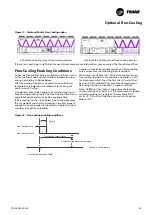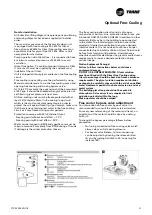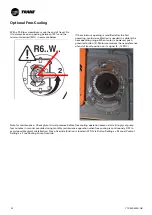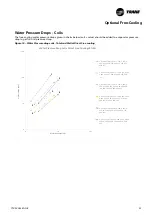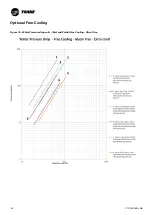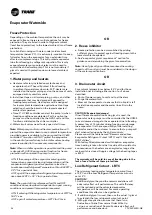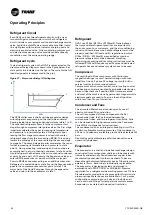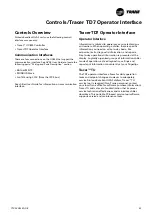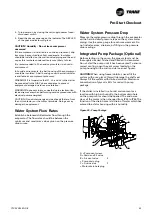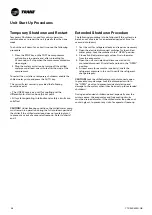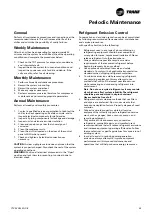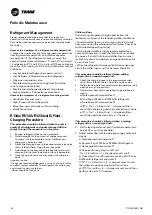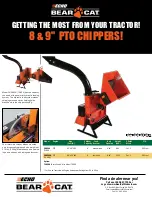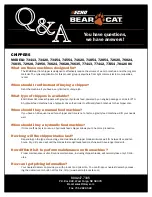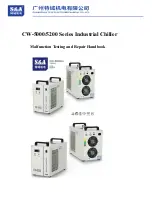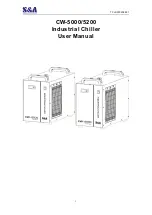
CTV-SVX009D-GB
36
4
UNT-PRC002-GB
Technical Data
FWD
08
12
20
30
45
Power supply
(V/Ph/Hz)
230/1/50
Capacities
Cooling capacity on water (1)
(kW)
5,2
8,3
15
18,8
30,1
Heating capacity on water (2)
(kW)
6,3
11,9
18,9
20,9
38,2
Fan motor
(type)
2 x direct drive centrifugal
Fan power input (3)
(kW)
0,23
0,46
0,65
1,04
1,51
Current amps (3)
(A)
1,1
2,2
3,1
4,7
5,5
Start-up amps
(A)
3,2
5,5
9,3
14,1
16,5
Air flow
minimum
(m
3
/h)
490
980
1400
1800
2700
nominal
(m
3
/h)
820
1650
2300
3000
4500
maximum
(m
3
/h)
980
1970
2600
3600
5400
Main coil
Water entering/leaving connections
(type)
ISO R7 rotating female
(Dia)
3/4"
3/4"
1 1/2"
1 1/2"
1 1/2"
Electric heater (accessory for blower only)
Electric power supply
(V/Ph/Hz)
230/1/50
230/1/50 or 400/3/50
400/3/50
400/3/50
400/3/50
Heating capacity
(kW)
2/4
8
10
12
12
Hot water coil (accessory for blower only)
Heating capacity (4)
(kW)
6,3
12
17,4
22,4
34,5
G2 filter (filter box accessory)
Quantity
2
2
2
2
2
Dimensions ( LxWxth)
(mm)
386x221x8
486x271x8
586x321x8
586*421*8
586*621*8
G4 filter (filter box accessory)
Quantity
-
2
2
2
2
Dimensions ( LxWxth)
(mm)
-
486x264x48
586x314x48
586*414*48
586*614*48
Condensate pump (accessory)
(type)
Centrifugal
Water flow - lift height
(l/h - mm)
24 - 500
Not available for FWD30 and FWD45
Sound level (L/M/H speed)
Sound pressure level (5)
(dB(A))
36/40/43
38/41/44
46/50/53
47/52/57
47/52/58
Sound power level (5)
(dB(A))
46/50/53
48/51/54
56/60/63
57/62/67
57/62/68
Unit dimensions
Width x Depth
(mm)
890 x 600
1090 x 710
1290 x 820
1290 x 970
1290 x 1090
Height
(mm)
250
300
350
450
650
Shipped unit dimensions
Width x Depth
(mm)
933 x 644
1133 x 754
1333 x 864
1333 x 1008
1333*1133
Height
(mm)
260
310
360
460
660
Weight
(kg)
32
46
61
76
118
Colour
galvanised steel
Recommended fuse size
Unit alone (aM/gI)
(A)
8/16
8/16
8/16
8/25
8/25
Unit with electric heater (gI)
(A)
16 (2kW),25 (4kW)
40 (230V),3*16 (400V)
3*20
3*25
3*25
(1) Conditions: Water entering/leaving temperature: 7/12 °C, Air inlet temperature 27/19°C DB/WB - Nominal air flow
(2) Conditions: Water entering/leaving temperature: 50/45 °C, Air inlet temperature 20°C DB - Nominal air flow
(3) At high speed with nominal air flow.
(4) Water entering/leaving temperature 90/70 °C, air inlet temperature 20 °C DB, Nominal air flow.
(5) A rectangular glass wool duct 1m50 long is placed on the blower.The measurement is taken in the room containing the blower unit.
Heat exchanger operating limits:
FWD:
*water temperature: max 100° C
*absolute service pressure: min 1 bar/max 11 bars
Accessories - Hot water coil:
*water temperature: min. +2° C/max. 100° C
*absolute service pressure: min 1 bar/max 11 bars
Freeze Protection
Depending on the ambient temperature the unit may be
exposed to freeze, there are multiple options for freeze
protection. They are listed in order of highest ambient
(least freeze protection) to the lowest ambient (most freeze
protection).
For all chiller running with water under cold ambient
temperature (below 0°C), it is extremely important to keep
full water flow in the evaporator for an extended time
after last compressor stops. This will protect evaporator
tube from freezing by refrigerant migration. This is why
evaporator water pump output relay must be used to
control the chilled water pump. This is not mandatory if
glycol is used with protection down to lowest ambient
expected.
1. Water pump and heaters
a. Heaters are factory installed on water boxes and
evaporator shell. They will protect it from freezing
in ambient temperatures down to -20°C.Heaters are
installed on the water piping and on the pumps of units
equipped with hydraulic module.
b. Install heat tape on all water piping, pumps, and other
components that may be damaged if exposed to
freezing temperatures. Heat tape must be designed
for low ambient temperature applications. Heat tape
selection should be based on the lowest expected
ambient temperature.
c. Tracer™ UC800 controller can start the pump(s) when
freezing conditions are detected. For this option the
pumps must be controlled by the GVAF unit and this
function validated on the chiller controller.
d. Water circuit valves need to stay open at all times.
Note:
Water pump control and heater combination will
protect the evaporator down to any ambient temperature
provided power is available to the pump and the UC800
controller. This option will NOT protect the evaporator
in the event of power failure to the chiller unless backup
power is supplied to the necessary components.
Note:
When no chiller operation is possible and the pump
is already off, UC800 pump control function for freeze
protection will command the pump to turn on:
• ON if the average of the evaporator entering water
temperature, evaporator leaving temperature, and the
evaporator refrigerant pool temperature is less than
Low Evaporator Refrigerant Temperature Cutout (LERTC) +
2.2°C for a period of time
• OFF again if the evaporator refrigerant pool temperature
rise above LERTC + 3.3°C for a period of time
Note:
The period of time referenced for ON and OFF
conditions above described is dependent on past running
conditions and present temperature measured.
• ON if entering OR leaving water temperature < LWTC for
16.2°C-sec
• OFF again if water temperature > LWTC for 30 min
OR
2. Freeze inhibitor
a. Freeze protection can be accomplished by adding
sufficient glycol to protect against freezing down to the
lowest ambient expected.
b. See “evaporator glycol requirement” section for
guidance on determining the glycol concentration.
Note:
Use of glycol type antifreeze reduces the cooling
capacity of the unit and must be considered in the design
of the system specifications.
OR
3. Drain water circuit
For ambient temperatures below -20°C and for those
installation not including either option 1 or 2 above
described
a. Shut off power supply to unit and to all heaters.
b. Purge the water circuit
c. Blow out the evaporator to ensure that no liquid is left
inside the evaporator and the water lines. Drain the
pump.
CAUTION! Evaporator damage!
If insufficient concentration or no glycol is used, the
evaporator water pumps must be controlled by the UC800
to avoid severe damage to the evaporator due to freezing.
A power loss of 15 minutes during freezing can damage
the evaporator. It is the responsibility of the installing
contractor and/or the customer to ensure that a pump will
start when called upon by the chiller controls.
Please consult the table named “Recommended Low
Evaporator Refrigerant Cutout (LRTC) and % Glycol for
GVAF chillers”.
With factory-fitted disconnect switch option, evaporator
trace heating is taken from the live side of the isolator. As
a consequence, the heaters are energized as long as the
main switch is closed. Supply voltage to the heating tapes
is 400V.
The warranty will be void, in case of freezing due to the
lack of use of either of these protections.
Low Refrigerant Cutout - LRTC
The minimum leaving water temperature cutout is set
at 2.2°C and the Low Refrigerant Temperature cutout is
set at 0°C.
CAUTION!
1. Additional glycol beyond the recommendations will
adversely affect unit performance. The unit efficiency
will be reduced and the saturated evaporator
temperature will be reduced. For some operating
conditions this effect can be significant.
2. If additional glycol is used, then use the actual % glycol
to establish the low refrigerant cutout set point.
3. With glycol application, ensure that there is no
fluctuation of brine flow versus Order Write Up
value, as a reduction of flow will adversely affect unit
performance and behaviour.
Evaporator Waterside








